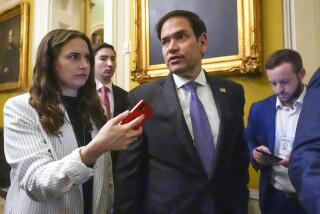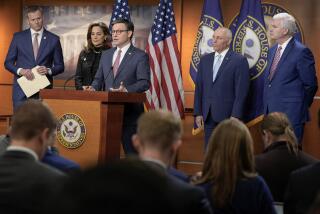FBI has been using drones since 2006, watchdog agency says
WASHINGTON – Operating with almost no public notice, the FBI has spent more than $3 million to operate a fleet of small drone aircraft in domestic investigations, according to a report released Thursday by a federal watchdog agency.
The unmanned surveillance planes have helped FBI agents storm barricaded buildings, track criminal suspects and examine crime scenes since 2006, longer than previously known, according to the 35-page inspector general’s audit of drones used by the Justice Department.
The FBI unmanned planes weigh less than 55 pounds each and are unarmed, the report said. The FBI declined requests to discuss its drone operations Thursday.
In June, Robert S. Mueller III, then director of the FBI, acknowledged the existence of the drone program for the first time during congressional testimony.
Mueller, who retired Sept. 4, said the bureau was in the “initial stages” of writing privacy policies so agencies flying the unmanned aircraft would avoid improper surveillance of Americans. “We’re exploring not only the use but also the necessary guidelines for that use,” he said.
But the auditors determined that the FBI had not addressed the danger of violating privacy rights, and recommended that the deputy attorney general’s office consider writing new guidelines to curb improper surveillance by law enforcement drones.
Officials from the FBI and the Bureau of Alcohol, Tobacco, Firearms and Explosives told auditors that there was “no need” to write new privacy guidelines, the report said.
The FBI relies on existing aerial surveillance policies to guide how agents fly drones, and ATF officials are writing a checklist on how agents should use them, the report said.
Drones can be less expensive and can fly closer to homes and into some areas hidden from aerial view more safely than manned aircraft, said Amie Stepanovich, director of the domestic surveillance project at the Electronic Privacy Information Center, a Washington-based watchdog group.
“They raise the stakes when it comes to surveillance, and we haven’t seen government agencies address the increased risks [to privacy] in any meaningful manner,” Stepanovich said.
Auditors also found that the ATF had bought drones and planned to use them. The U.S. Marshals Service and the Drug Enforcement Administration, which also fall under the Justice Department, purchased and tested drones but decided not to deploy them in active operations.
In addition to buying drones for internal use, the Justice Department has awarded at least $1.2 million to local police departments to purchase small drones, but failed to track how the money was spent, the audit found.
None of the drones purchased with Bureau of Justice Assistance grant funds were used in police actions, auditors found.
Surveillance drones have been useful to the FBI in situations when the lives of agents are at risk, said a law enforcement official who was not authorized to speak publicly about the sensitive technology.
Cameras and sensors mounted on drones can track movement in the dark and detect heat signatures of people hiding on the ground. Drones can give agents aerial views of an active crime scene without putting a pilot in danger of being shot down, he said.
In February, for example, a drone with a 9-foot wingspan was used by the FBI to watch the entrance to a bunker in Alabama where a 65-year-old gunman held a 5-year-old boy hostage. After a standoff, an FBI team stormed the bunker, rescued the boy and shot the man.
In addition to flying its own drones, the FBI has at least once made use of a large Predator surveillance drone flown by Customs and Border Protection along the Canadian border, current and former law enforcement officials said.
In February 2011, the FBI requested that a Department of Homeland Security Predator drone based in Grand Forks, N.D., collect aerial images along its route through the western end of Washington state.
Agents wanted more detailed surveillance photos of the house of Martin Luther King Jr. Day bomber Kevin W. Harpham, according to an official familiar with the operation. As the drone flew overhead, video and infrared images of the pine-studded hills around Harpham’s property were transmitted to FBI agents using a password-protected law enforcement website called Big Pipe.
The FBI used the videos of footpaths and outbuildings on the rural property to plan the raid that captured Harpham on March 9, 2011.
ALSO:
Baby Veronica, Cherokee girl, returned to adoptive parents
Could this explorer have found a real pirate treasure trove?
Former President George H.W. Bush witness at same-sex marriage
Follow L.A. Times National on Twitter
Twitter: @bybrianbennett
More to Read
Start your day right
Sign up for Essential California for news, features and recommendations from the L.A. Times and beyond in your inbox six days a week.
You may occasionally receive promotional content from the Los Angeles Times.







